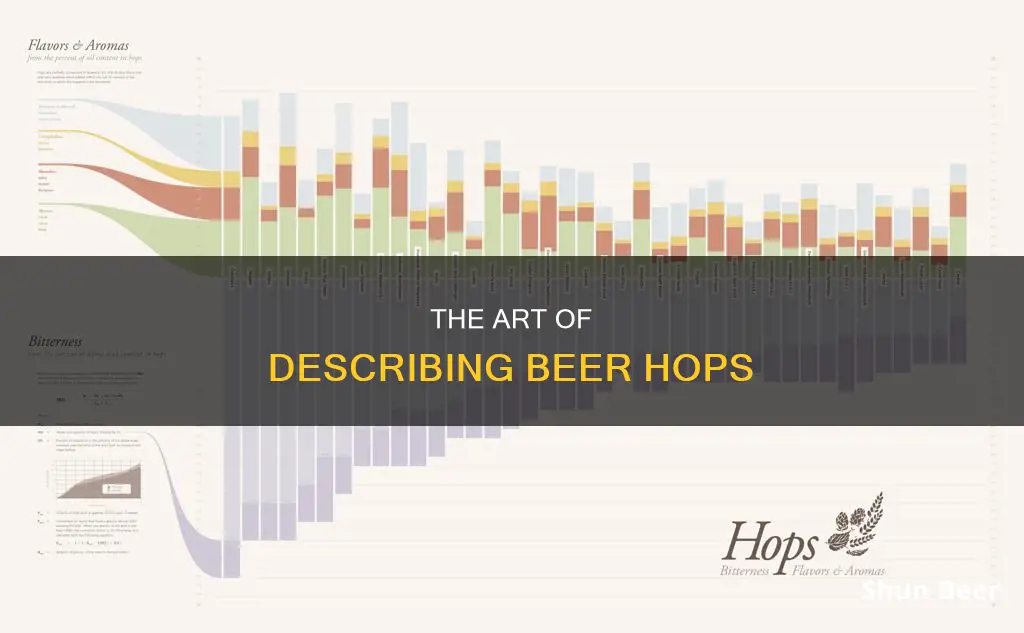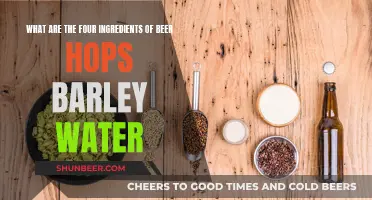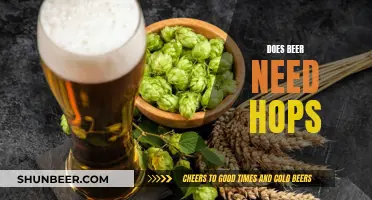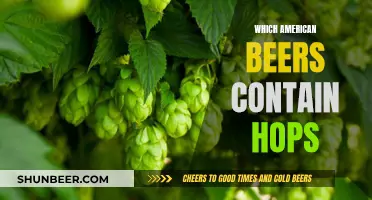
Hops are the flowers of the hop plant, Humulus lupulus, a member of the Cannabaceae family of flowering plants. They are one of the basic ingredients in beer brewing, alongside grain, yeast, and water. Hops are added to the boil stage of brewing, as it takes a long time to unleash the alpha acids that bitter and balance the sweetness of the malt. Hops are most often associated with bitterness, but they also add aroma and flavour to beer. The type of hops used in brewing, when they are added to the wort, and how long they are boiled can all affect the final beer's flavour.
What You'll Learn

Hops are cone-shaped flowers of the Humulus lupulus plant
The Humulus lupulus plant is a vigorous, climbing, herbaceous perennial, usually trained to grow up strings in a field. The plant has separate female and male varieties, and only female plants are used for commercial hop production. The female plants are propagated vegetatively, while the male plants are culled if grown from seeds.
Hops contain different oils, such as lupulin, a yellowish, waxy substance that imparts flavour and aroma to beer. Lupulin contains lupulone and humulone, which have antibiotic properties and help suppress bacterial growth, favouring the growth of brewer's yeast. The hop cones also contain beta acids or lupulones, which contribute desirable aromas to beer.
The main components of hops essential oils are terpene hydrocarbons, including myrcene, humulene, and caryophyllene. Myrcene is responsible for the pungent smell of fresh hops, while humulene and its oxidative reaction products may give beer its prominent hop aroma. Together, these three terpene hydrocarbons represent 80 to 90% of the total hops essential oil.
Hops are divided into two general varieties: bittering hops and aroma hops. Bittering hops have higher concentrations of alpha acids, making them ideal for bittering beer economically. Aroma hops, on the other hand, tend to have more essential oils that contribute to the "hoppiness" of the beer, with aromas like citrus, pine, mango, resin, and melon.
Bock Beer and Hops: A Complex Relationship
You may want to see also

They add bitterness, flavour, and stability to beer
Hops are added to beer during the brewing process to introduce bitterness, flavour, and stability. They are the flowers or cones of the female hop plant, Humulus lupulus, and contain bittering compounds and aroma constituents.
The bitterness in beer comes from alpha acids, which are found in the lupulin glands of hops. These alpha acids isomerise during the brewing process, forming iso-alpha acids that contribute to the bitter flavour associated with beer. The longer the hops are boiled, the more bitter the beer will become, as the iso-alpha acids are soluble and increase in concentration with boiling time.
Beta acids, also found in the lupulin glands, contribute to the harsher bitterness of beer. They do not isomerise during fermentation but slowly oxidise over time, producing their bitter flavour. The longer the beer is fermented and aged, the more potent the bittering effect of beta acids becomes.
In addition to bitterness, hops also impart flavour and aroma to beer. The essential oils found in hops, such as myrcene, humulene, and caryophyllene, are responsible for the hoppy aroma of beer. These oils are volatile and can evaporate easily, so brewers often add hops later in the brewing process or use techniques like dry hopping to maximise their flavour and aroma contribution.
Hops also provide stability to beer by acting as a preservative. They contain antibacterial compounds that suppress the growth of undesirable microorganisms, thereby extending the shelf life of beer. Additionally, the acids within hop resin are antimicrobial, helping to curb the development of off-flavours and spoilage during fermentation and in the finished beer.
Mexican Beer and Hops: A Complex Relationship
You may want to see also

Hops are divided into two types: bittering and aroma
Hops are the flowers (also called seed cones or strobiles) of the hop plant Humulus lupulus. They are used as a bittering, flavouring, and stability agent in beer, adding bitterness, floral, fruity, or citrus flavours, and aromas. Hops are divided into two types: bittering and aroma.
Bittering Hops
Bittering hops have higher concentrations of alpha acids, which are the main source of bitterness in beer. They are responsible for the bitter flavour of a beer. European ("noble") hops typically average 5–9% alpha acids by weight (AABW), while newer American cultivars range from 8–19% AABW. The longer the hops are boiled, the more bitter the beer. Bittering hops are boiled for a longer period of time, typically 60–90 minutes, and often have inferior aromatic properties as the aromatic compounds evaporate during the boil.
Aroma Hops
Aroma hops usually have a lower concentration of alpha acids (around 5%) and are the primary contributors of hop aroma and flavour (without the bitterness). Aroma hops are typically added to the wort later in the brewing process to prevent the evaporation of the essential oils, which contribute to the "'hoppy' aroma and flavour. Aroma hops are often added after the wort has cooled and while the beer ferments, a technique known as "dry hopping", which enhances the hoppy flavour.
Sour Beers: Do They Have Hops?
You may want to see also

They are grown in moderate climates with rich soil and sunshine
Hops are the flowers, or cones, of the Humulus lupulus plant. They are a key ingredient in beer, providing desirable flavour, aroma, and bittering qualities. Hops are hardy plants and are grown all over the world.
Hops grow best in moderate climates with rich soil and abundant sunshine. These ideal regions generally sit at similar latitudes on the world map, both northern and southern. For example, the Pacific Northwest in the US is a major hop-growing region due to its milder weather and reliable precipitation.
Well-drained, nutrient-rich soil is a must for growing hops, as the roots are key to the production and longevity of the plant. Hops also require full sun (at least 6-8 hours daily) for plant health and cone production.
Hops are a very fast-growing plant and require a lot of water. They are a climbing plant and are usually trained to grow up strings or wires that support the plants and allow them to grow taller without needing to build structural cells.
The hop plant has separate female and male plants, and only female plants are used for commercial production. The female plants are propagated vegetatively, and the male plants are culled if plants are grown from seeds.
Hops in Beer: Necessary or Overrated?
You may want to see also

Hops are added to the boil stage of brewing
The timing of when the hops are added to the boil also affects the flavour and aroma of the beer. Bittering hops are boiled for a longer period of time, typically 60-90 minutes, and often have inferior aromatic properties as the aromatic compounds evaporate during the boil. Aroma hops, on the other hand, are typically added to the wort later, during the final 30 minutes or 10 minutes of the boil, to prevent the evaporation of essential oils and to impart "hop taste" or "hop aroma".
Hops are the flowers, or cones, of the plant called Humulus lupulus, which is a member of the Cannabinaceae family, which also includes Cannabis (hemp and marijuana). Hops are used primarily as a bittering, flavouring, and stability agent in beer. They add bitterness, floral, fruity, or citrus flavours, and aromas to the beer. Hops also have antibacterial effects and help to extend the shelf life of beer by suppressing bacterial growth and acting as a preservative.
How NA Beer is Brewed Without Hops
You may want to see also
Frequently asked questions
Hops are the flowers, or cones, of the female hop plant, known as Humulus lupulus. They are a member of the hemp or Cannabinaceae family, which also includes the cannabis plant.
Hops add bitterness, flavour and aroma to beer. They also act as a preservative, helping to keep beer fresh for longer.
Hops are very bitter. They counter the sweetness of the malt in beer to create a more balanced flavour.
Hops contain alpha and beta acids, which are released when boiled and become part of the brew.







